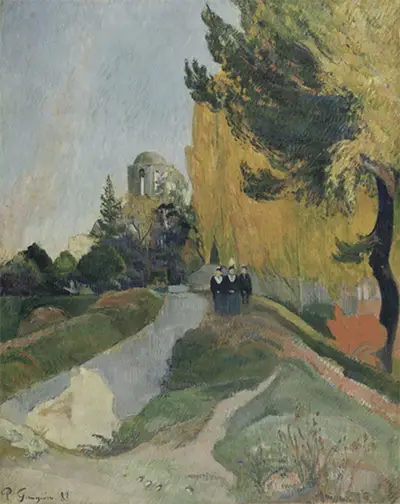The roman necropolis was sanctified by the Arles' first bishop, saint Trophime, an entombment land for Christians in the 3rd century. In the 19th century, only avenues of the cypresses and a few empty sarcophagi remained of the site, which provided it with a gloomy reflective air. Paul Gauguin arrived in Arles in October 1888 after his friend Vincent Van Gogh sent him a work invitation. The two painters had been in contact for some months, documenting their efforts to create a non-naturalist landscape. Les alyscamps painting with its blazing brisk colours is most likely one of Gauguin's initial paintings in Arles. Paul eliminated historical mentions almost completely, leaving just the arched tower and a fraction of the edifice of the St Honorat chimeric basilica erected on the plot’s locale.
There are no sarcophagi in a display, just the grounds, woods, and inland waterway where three persons are strolling, two ladies in Arlesiennes’ dressing and a man. Paul, who did not exacting find Arlesiennes eye-catching, paradoxically named his canvas terrain. Through its put-together masses and marking, this work of art is a feature of Paul Gauguin's synthetism. The brushstrokes, facsimiled from Cezanne, permitted him to write out the design without replicating the actual globe. The vastly drenched shades are also a skewed and enhancing explanation of the landscape. This tranquil sight of Les alyscamps compares with the tormented existing compositions that Van Gogh painted of the place.
Paul's outlooks on art were profoundly influenced by his legal custodian, Gustave Arosa, whose art compilation included Camille Corot's works, Jean Francois Millet, and Eugene Delacroix. With his attention irked, Paul Gauguin started painting with a fellow stockbroker, Emile Schuffenecker, and his aspiration to become an artist was established after seeing his first copier exposition in 1874. Paul Gauguin's influences are shown through his art procurements. He spent 17,000 francs on pieces by Monet, Manet, Sisley, Pissarro, Guillaumin and Renoir. Paul's artwork was also inherently influenced by the many tight artistic relationships he developed with fellow painters like Charles Laval. Paul Gauguin was firstly mentored by Pissarro, who gave individual attention to his work of art. Pissarro stressed the call for Paul to build up an artistic technique suitable to his nature.

